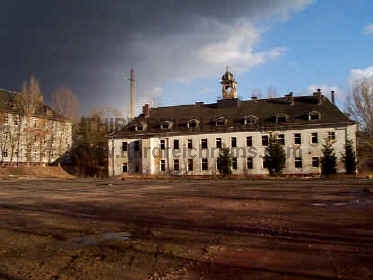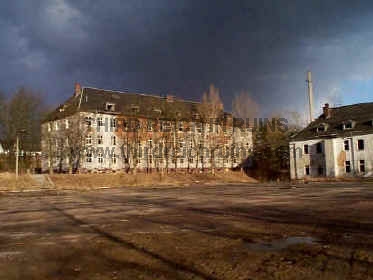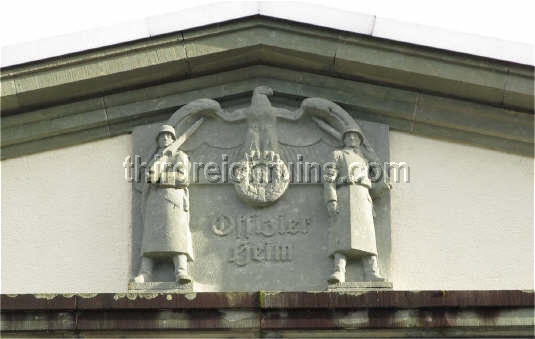|
Wehrmacht Posts
/ Kaserne
Part 3
Part 3 features Wehrmacht military
posts in the following locations: Thüringen - Meiningen; Bavaria
- Füssen; Rheinland-Pfalz - Baumholder,
Bad Kreuznach; Baden-Württemberg - Schwetzingen,
Mannheim, Heidelberg, Wertheim; Hamburg;
Niedersachsen - Bergen-Hohne, Wolfenbüttel;
Hessen - Friedberg, Gelnhausen.
Note: This page shows only a
few such sites ... I would be very pleased to hear from anyone
who would like to share similar then-and-now photos from other Wehrmacht posts
in Germany. Contact me at: walden01 (at) comcast.net.
To view various Wehrmacht Kaserne
sites in northern Germany, visit the Forgotten
History page.
Note: After
abandonment by the military and return to the German government, many 1930s-era
Kaserne are either partially or totally torn down, so the buildings shown here
in modern photos may no longer be there.
Meiningen
(Thüringen)
 |
 |
| Two
Kaserne were built in the southern Thüringen city of Meiningen during
the Third Reich period, and other older posts were remodeled during the
1930s. These postcards show the Artillerie-Kaserne, or Barbara-Kaserne
(St. Barbara being the patron saint of artillerymen). The
Barbara-Kaserne was built from 1935-36 to house units from the 2nd and
(later) 4th Panzer Divisions. (MapQuest
Map Link) |
 |
 |
| The
Drachenberg-Kaserne was built in 1935 for the staff of Panzer-Brigade 2,
and other units. The Drachenberg-Kaserne was used after the war by East
German Border Guards, and is still in use today by German border troops
(the buildings have been somewhat modified from their 1930s
appearance). (period postcards) |
 |
 |
| The
Hauptkaserne (Main Kaserne) was built in 1865-67, with further
modifications through the 1930s. The remaining buildings have been
preserved as business offices. Below - Schützen-Regiment-Meiningen
parades in front of the Hauptkaserne. (above - 1934-dated postcard) |
 |

|

|
The
Barbara-Kaserne was used by the Soviet military forces (parts of the 39th
Guards Motorized Rifle Division) during the Cold War, but the buildings
were abandoned following the Soviet pull-out in 1991. Note the similarity of these
buildings to those at Manteuffel Kaserne in
Bad Kissingen, which became Daley Barracks under the U.S. 2/11th ACR - the
opponents of the Soviet forces here in Meiningen.
(Note - this particular building was torn down ca. 2002, and the
destruction of this site will apparently continue.) |

|

|
Artillery units of the 2nd and 4th Panzer Divisions were
stationed here prior to World War II, then the post was used as a hospital
during the war. Since the pullout of
Soviet troops these buildings have become derelict, although they retain some
interesting reminders of their previous occupants, such as Russian
newspapers used as wallpaper backing, and flag holders above the doors
with Red Star insignia. |
 |
 |
 |
 |
| Buildings
of the Barbara-Kaserne as they appeared in 2005. These remaining
buildings were demolished in 2010 (thanks to Nicolas Flamel for info). |
 |
 |
Füssen
(Bavaria)
 |
 |
| This
military barracks was built in Füssen for Gebirgs Artillerie - Mountain
Artillery troops. It is called the Allgäu Kaserne today, and still has a
painted mural of a Mountain Troops soldier on the wall. (courtesy
Jeff Clark) (Google
Maps link) |
 |
Baumholder
(Rheinland-Pfalz)
 |
 |
| A military training area
and large weapons range complex was established in 1937 near the village of Baumholder. This Kaserne was
occupied in 1945 by the French Army, then by the U.S. Army in 1951 as
H.D. Smith Barracks. The period view shows Allied vehicles occupying
Baumholder shortly after the end of the war. (Google
Maps link) |
 |
 |
| Perhaps
the most interesting aspect of the Baumholder Kaserne is this stone
swastika, built into the side of a former administration building.
Although slightly altered during a 2013 remodeling, the swastika is
still there today, certainly one of the more unique remains of the Third
Reich (see here). |
Bad
Kreuznach (Rheinland-Pfalz)
 |
 |
| Hindenburg Kaserne was
built in Bad Kreuznach in 1938. The main buildings had decorative slate
work over the roof windows featuring eagles with swastikas, crosses,
swords, and coats of arms (see
more here). The complex was occupied by the U.S. Army in March 1945,
but then turned over to the French Army. The U.S. Army again took the
Kaserne over in 1951, renaming it Rose Barracks in honor of Maj. Gen.
Maurice Rose, commander of the 3rd Armored Division, killed in World War
II (the Kaserne in Vilseck is also named for Gen. Rose). The Kaserne was
turned back over to German control during the drawdown of U.S. forces in
Germany in the mid-1990s. (Google
Maps link) |
 |
 |
Schwetzingen
(Baden-Württemberg)
 |
 |
| A Panzer Kaserne for Panzer
Regiment 23, designed by Dieter Lang and Fritz Schmitt, was built
outside the town of Schwetzingen in 1937-38. The U.S. Army occupied this
post as Tompkins Barracks from 1945-2013. These photos show the main
gate building. (Gerdy Troost, "Das Bauen im neuen
Reich," Vol. 2, Bayreuth, 1943) (Google
Maps link) |
 |
 |
 |
| A unique
1938 mosaic of two armored knights ("Die Gepanzerten")
decorates the gate house. |
 |
 |
| Views
from 1938-1941 of the main gate (above) and main buildings of the
Kaserne (below), with corresponding views today. (period
postcard views from usarmygermany.com) |
 |
 |
 |
 |
Mannheim (Baden-Württemberg)
 |
 |
| Fliegerhorst
Kaserne in Mannheim-Sandhofen was established in 1937 at a pre-war
airfield. The post is used today by the U.S. Army as Coleman
Barracks. (Google
Maps link) |
 |
 |
| Gallwitz
Kaserne in Mannheim was built in the late 1930s. The U.S. Army used this post as Funari Barracks. The post is now closed
and locked up. (period postcards) (Google
Maps link) |
 |
 |
 |
 |
| Kaiser-Wilhelm-Kaserne
was built in Mannheim in 1901. When these photos were taken ca. 1936,
the post was the home of Artillerie-Regiment 69. The U.S. Army used the
post as Turley Barracks from 1945 until about 2009. When the
modern photos were taken in 2016, most of these buildings were being
remodeled as office buildings (see the photos at bottom). (photos
donated) (Google Maps link) |
 |
 |
 |
 |
 |
 |
 |
 |
Heidelberg
(Baden-Württemberg)
 |
 |
| Großdeutschland
Kaserne was built in Heidelberg in 1937, and so-named in 1938 after
Austria joined the German Reich. The modern view above shows the street side of the main building; the
period photo shows the other side (parade field side). The post had several military sculpture decorations - two eagles at the
main gate (see here), soldier
figures on the façade of the headquarters building (below), and soldier
relief carvings at the doorways to other buildings inside the post. The
U.S. Army used the post as Campbell Barracks from 1945-2013; for many
years this was the headquarters of U.S. Army Europe (USAREUR). (Google
Maps link) |
 |
 |
Wertheim
(Baden-Württemberg)
 |
 |
| A
Fliegerhorst (airfield) was built in Wertheim in 1937. Stuka units and
others flew from there during World War II. The Kaserne was used by the
U.S. Army from 1945-1992 as Peden
Barracks; it is now a business park. (Prof. Gerdy Troost, "Das Bauen im Neuen Reich,"
Part 2, Bayreuth, 1943) (Google
Maps link) |
Friedberg
(Hessen)
Gelnhausen
(Hessen)
 |
 |
| Herzbachkaserne
was built in Gelnhausen in 1936. This was (and is) one of the most
attractive Kaserne sites in Germany, with barracks and administration
buildings surrounding a lake. The post originally housed Panzer Abwehr
Abteilung 9 (anti-tank battalion). The U.S. Army arrived in 1945 and
used the post as Coleman Barracks until 1994. Gen. Colin Powell was
stationed here as a Lieutenant in 1958-60 and a street is still named
for him. The barracks buildings are now used to house refugees, with a
Police station in one of the buildings. Below - one of the gate
buildings. (period postcards) (Google Maps link) |
 |
 |
 |
| The
weather vane on the cupola of what was the Wehrmacht administration
building and officers club features an artillery piece and the date 1936. |
 |
 |
 |
 |
| What
makes this one of the most interesting Kaserne sites in Germany is the
series of nine red sandstone relief carvings above the barracks building entry doorways,
depicting various military conflicts in Germanic history. Above -
Roman soldiers prepare siege weapons and attack their enemies from
chariots. Below - Romans fight Germanic
Cimbri and Teutonic tribesmen, ca. 100 B.C. The Germanic soldier in the
center has a swastika on his shield. (info from http://www.gudrunkauck.de/Gelnhausen-Kaserne.html
by Gudrun Kauck) |
 |
 |
-
 |
 |
| Above -
The Germanic leader Arminius
(Armin the Cherusker, Hermann the German) successfully battles the
Romans in the Teutoburg Forest. Below - Said to portray Siegfried, hero
of the Nibelung Saga. One of the figures (Siegfried?) is wearing a
swastika brooch on his tunic. |
 |
 |
 |
 |
| Above -
Saxon King Heinrich I (Henry the Fowler) leads German forces against
Hungarians (Magyars) and other enemies. Below left - Thirty Years War
(1618-1648). Below right - Napoleonic Wars - Baron von Stein (Heinrich
Friedrich Karl von und zu Stein) as a Prussian leader during the defeat
of Napoleon's French army in 1813-1815. |
 |
 |
 |
 |
| In a
contemporary (1936) salute to the Kaserne's anti-tank battalion, this
vignette shows a German Army crew engaging what appear to be Russian T26
tanks with their 3.7cm Pak 36 anti-tank gun. Note the
ammunition handler at far right, lying on the ground and handing a
cartridge forward to the gun loader. |
 |
| The
final relief depicts a Wehrmacht soldier of 1936 clasping hands with an
SA Mann (left) and a factory worker or smith (right), with the legend IM
JAHRE DER EHRE 1936 (In the Year of Honor 1936). To the left of the
central group (below left) are figures depicting an architect, a doctor
(?), a girl in a BDM jacket (Bund Deutscher Mädel), and a mother with
child. The group to the right (below right) includes a mother with a boy
in HJ uniform (Hitler Jugend) and figures that have been defaced by
explosive and/or machine gun damage (several of the previous figures
also show bullet damage, probably from 1945). These final figures are unclear, but may show a
farmer couple in Trachten (regional costume), and the final
figure is evidently a journeyman carpenter, from his distinctive
bell-bottom pants. |
 |
 |
Hamburg
 |
 |
| A Kaserne named for the
capture of Fort Douaumont at Verdun during WW1 was established in
Hamburg in the early 1930s. The Kaserne serves today as a Bundeswehr
University. A large pylon with an eagle remains in front of the Kaserne.
(period postcards in author's collection) (Google
Maps link) |
 |
 |
 |
| A
monument honoring the German East Africa troops in WW1 was built
adjacent to Estorff Kaserne in Hamburg. The monument also honored
Rommel's Akrika Korps after WW2. The monument still exists in a gated park;
today the eagle bears an iron cross instead of a swastika. (period
postcard in author's collection) (Google
Maps link) |
Bergen-Hohne
and Wolfenbüttel (Niedersachsen)
 |
 |
| The
Bergen-Hohne Kaserne has served as a training area since 1935. Today it
is used by both the British Army and the German Bundeswehr. The building
seen here was the Wehrmacht Offizier Heim. Today it is a British Army
community center called the Roberts Roundhouse, or just the Roundhouse.
(Google
Maps link) |
 |
 |
 |
 |
-
 |
 |
| Flak
Kaserne in Wolfenbüttel was built in 1935 for Flak Regiment 36. The
post's appearance has changed very little, but it is no longer used by
the military. (period
postcard) (Google
Maps link) |
 |
 Back to Wehrmacht
Posts Part 1
Back to Wehrmacht
Posts Part 1
 Return to the "Third
Reich in Ruins" homepage
Return to the "Third
Reich in Ruins" homepage
|
